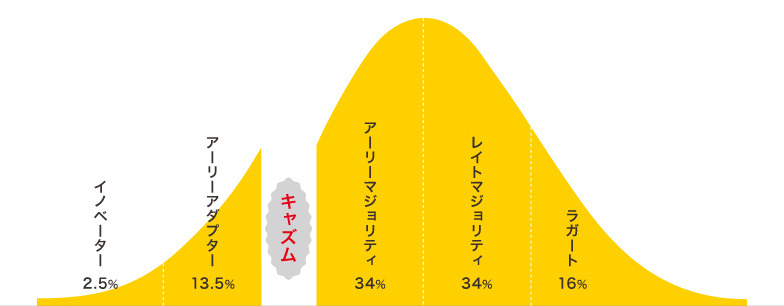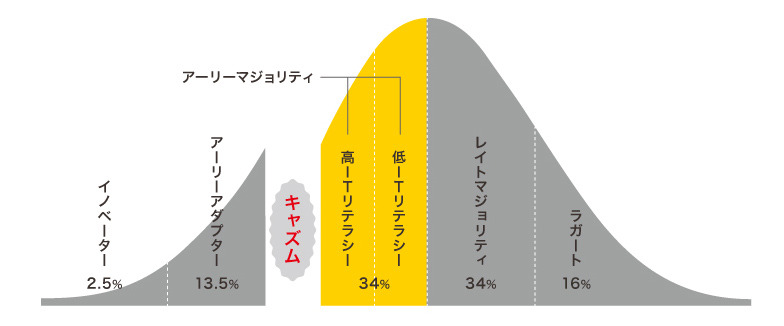Applying the Chasm Theory to IT Services
When Web Services Stop Growing
"There should be more target users, yet the user count has plateaued."
"The CPA (Cost Per Action—the cost incurred until a set action like member acquisition, app download, or payment) for direct ads has been rising sharply lately."
"We started a referral campaign, but membership isn't growing at all."
Sometimes, the growth of a web service or app with perceived potential stalls before reaching the targeted business scale or goals.
Today, we'll discuss key considerations for deciding when to implement marketing strategies or growth hacking tactics to address this issue.
The Unexpected Existence of a Chasm
Such situations frequently occur daily in the IT industry. Even as a user, haven't you ever thought, "That entrepreneur is often featured in business magazines, but I've never actually used the service he created," or "I personally find this web service or app interesting, but it's not really catching on around me"?
If the root cause is flawed service design—such as incorrect target audience selection or misaligned value proposition ( refer to previous article )—then a strategic reassessment or even withdrawal may be necessary at the business strategy level, or perhaps even at the core philosophy level.
However, if that's not the case, it doesn't seem like a major overhaul is needed, such as drastically changing the marketing strategy or implementing large-scale growth hacking initiatives that require significant scope and effort. This is where the perspective of the Chasm Theory becomes useful.
What is the Chasm Theory?
The Chasm Theory (from the English word for a fissure or gap in the earth's surface) is a globally renowned marketing strategy theory originally focused on new technologies in high-tech industries like semiconductors and hardware. Since Jeffrey Moore proposed it in 1991, his seminal book "Crossing the Chasm" has become one of the world's leading business books. It continues to evolve today, with sequels still being published, making it a theory/methodology that remains in active development.
Moore systematically analyzed user acquisition and appeal methods based on the Innovator Theory proposed by Stanford sociologist Everett M. Rogers in 1962.
The Innovator Theory posits that as new products or services spread, the adoptable user base expands according to sensitivity to information and trends, and technological literacy. Organizing this, users can be profiled into five segments: Innovators, Early Adopters, Early Majority, Late Majority, and Laggards.

The significant gap in value criteria between the innovative early adopters and the early majority is termed the chasm. This gap becomes particularly pronounced when high-tech industries penetrate markets and develop as businesses. The Chasm Theory analyzes methodologies for crossing this divide. (See figure below)

In contrast, the Innovation Theory, which formed the basis for the Chasm Theory, takes a slightly different perspective. It argues that while the first two layers can be acquired if novelty or interest is even slightly stimulated, capturing the subsequent layers requires strengthening and appealing to different motivations. Since innovators represent 2.5% of the total market and early adopters 13.5%, the "16% Adoption Rate Logic" emphasizes that new businesses must first achieve this level of adoption to reach the chasm.
Since this isn't a book review, I encourage you to read it for details, but this approach isn't limited to the high-tech industries it targets. It's also applicable to selecting targets for consumer-facing applications and web services, especially those not based on cutting-edge technology.
Specifically, even among target personas sharing the same age, gender, income, and hobbies, the actual timing of becoming a user can subtly shift based on IT literacy and trend sensitivity. Consider a scenario where a service is good and the target selection is correct, yet it fails to gain traction. Applying the theory above in such cases suggests adjusting the contact points and messaging used to appeal to users, monitoring the situation after service launch.
Phase and Contact Point Overview
So, how exactly should you approach this? Below, we've organized examples of target personas, corresponding appeal messages, and suggested marketing and growth hacking strategies.

The fundamental characteristics of each target group align with the settings from the Innovator Theory and Chasm Theory. However, as mentioned earlier, acquiring users up to the Early Adopter stage can be achieved relatively quickly with standard promotional tactics—such as PR ads in tech media, digital banner ads, and search listings—combined with simple service improvements like bug fixes.
For web services and apps, the low barrier to entry is compounded by the fact that providers and users often belong to relatively small, interconnected communities (e.g., fellow engineers). Furthermore, services can be easily shared directly via social plugins, meaning users with high IT literacy and sensitivity quickly catch on and spread information, making them easier to capture in the short term. In other words, it's relatively easy for the geeky engineer crowd to pioneer the service as innovators, followed by early adopters who are drawn in and start using it too.
For services that fail to achieve even this stage, it may sound harsh, but it suggests either a fundamental misalignment in target audience selection or a need to fundamentally reevaluate the entire business or marketing strategy.
On the other hand, to cross the chasm, creating use cases and fostering word-of-mouth through early adopters is essential. Building functional/performance-based validation based on the best practices they generate is necessary.
However, for IT services and apps, there's another key point. As mentioned above (bolded section), the early majority segment is divided based on IT literacy, so appeals must be tailored accordingly.
In other words, while their decision criteria—"If it's functional, has high service quality, and feels meaningful, they'll use it"—are the same, their points of contact with the service differ significantly based on IT literacy.

While "reliability and stability" and "word-of-mouth appeal" are important for both, the key difference lies in the sources of that information.
First, consider the highly IT-literate early majority. These are users who watch live-streaming videos by famous YouTubers with millions of fans or search for good options on industry-renowned app review sites that generate tens of millions of monthly page views. They also frequently check app store rankings and user reviews; if they see comments like "the app crashes," they won't use it. While innovators and early adopters may encounter the same touchpoints as these highly IT-literate early majority users, they tend to rely on their own intuition and experience, often trying the app first even if negative word-of-mouth exists. In contrast, the early majority has more limited sources for finding information. Rather than actively searching, they become users only after catching word-of-mouth or trustworthy information as exposure increases. The recent trend of using YouTubers for app promotion might be one way to capture this demographic.
The other group, the low IT literacy Early Majority, uses the same criteria for deciding to download or register, but their channels for making that judgment are narrower. They tend not to trust and act unless it's something like a TV commercial or word-of-mouth from a close friend. An example is TV commercials for apps that sell features like "very easy to use, runs smoothly." They typically feature celebrities or entertainers who seem relatable to the target user age group. I believe the trend of TV commercials for social games, which start around 3 million downloads or even as early as 1 million downloads, is also targeting this segment.
The next segment, the late majority, has lower IT literacy and trend sensitivity than the early majority. For them, popularity, proven track record, adaptability to network environments, and the stability of operations and support become even more crucial. The banner ads on relatively broad-targeted portal sites, ad networks, and SNS that proclaim "Achieved *** Million Downloads!!" are part of the appeal message specifically designed to capture this late majority.
The final group, the laggards, are users who only become users (and may never become users) when the environment is set up for everyone to start using it, such as when an app is pre-installed on a device.
For example, imagine a father whose entire family started using LINE nearly two years ago. Pressured by his wife, he reluctantly tries to install the app when he upgrades his phone. He can't figure out the account setup and ends up asking his daughter how to download it (ironically, this same father might be a major innovator in his own hobby areas like "fishing gear" or "cameras").
The only way to move them is by compelling them with a strong sense of necessity or obligation. Conversely, once the service has matured to the level of being used as infrastructure, this group will naturally adopt it. Therefore, I believe the focus should be on acquiring the preceding segments to advance the business. The business model's projection (likely only capturing about 80% of the market) and user design are actually crucial, even if profitability is achievable without capturing this segment.
Could you be stuck in the chasm right now?
What do you think? Among the "great services that seem to have already crossed the chasm but aren't catching on" in your daily life, some might have stopped appealing to the segment with lower IT literacy or trend sensitivity, as described above. If you're a web marketer encountering such situations, perhaps shifting your appeal strategy based on the perspectives introduced in this article could be worthwhile.
Next time, I plan to explore differentiation strategies within similar web/app services.
Was this article helpful?
Newsletter registration is here
We select and publish important news every day
For inquiries about this article
Back Numbers
Author

Tomohiro Katayama
Dentsu Inc.
Since graduate school, I have operated web services and sold the company. After joining the company, I have consistently been assigned to departments responsible for new business and product development. In new ventures, I have designed, launched, and grown numerous apps and web services for our company, clients, and media companies. In product development, I primarily focused on transforming cutting-edge digital technologies and methodologies—such as facial recognition, BI tools, MA, digital healthcare, blockchain, growth hacking, and open innovation—into solutions for advertising-adjacent fields where their application was anticipated.

